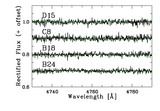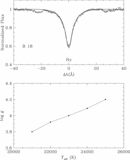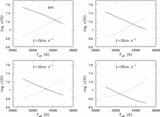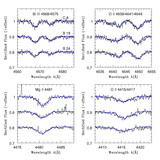Image Details
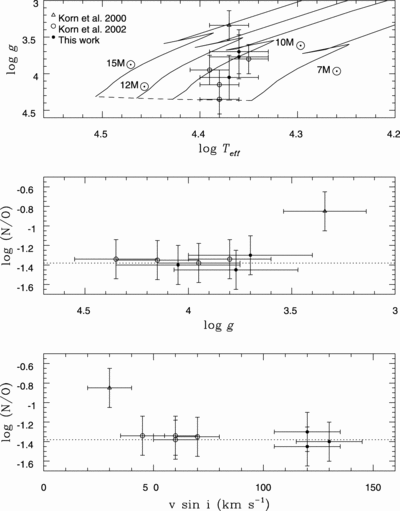
Caption: Fig. 5.
Top: Program stars (filled circles) and those of the same cluster analyzed by Korn et al. (2000, 2002; triangle and open circles, respectively) in comparison with evolutionary tracks for nonrotating stars of Schaerer et al. (1993). The dashed line indicates the zero‐age main sequence for ﹩Z=0.008﹩. Except for B30 in the blue Hertzsprung gap, all stars fall between the tracks for 8 and 11 M⊙ stars. Middle: The ﹩\mathrm{log}\,( \mathrm{N}\,/ \mathrm{O}\,) ﹩ ratio as a function of ﹩\mathrm{log}\,g﹩, as an indicator of the evolutionary status of the stars. The N/O ratio is expected to increase as the stars evolve along the main sequence. No evolution of ﹩\mathrm{log}\,( \mathrm{N}\,/ \mathrm{O}\,) ﹩ is seen on the main sequence. B30 shows an enhanced N/O ratio. The dashed line indicates the mean ﹩\mathrm{log}\,( \mathrm{N}\,/ \mathrm{O}\,) ﹩ of the three program stars. Bottom: The ﹩\mathrm{log}\,( \mathrm{N}\,/ \mathrm{O}\,) ﹩ ratio as a function of ﹩v\mathrm{sin}\,i﹩. No evidence for enhanced N/O ratios is found among the fast rotators. B30, however, is enhanced in N and depleted in O. We note that its low ﹩v\mathrm{sin}\,i﹩ value does not necessarily imply slow rotation. The dashed line indicates the mean ﹩\mathrm{log}\,( \mathrm{N}\,/ \mathrm{O}\,) ﹩ of the three program stars.
Copyright and Terms & Conditions
© 2005. The American Astronomical Society. All rights reserved. Printed in U.S.A.


